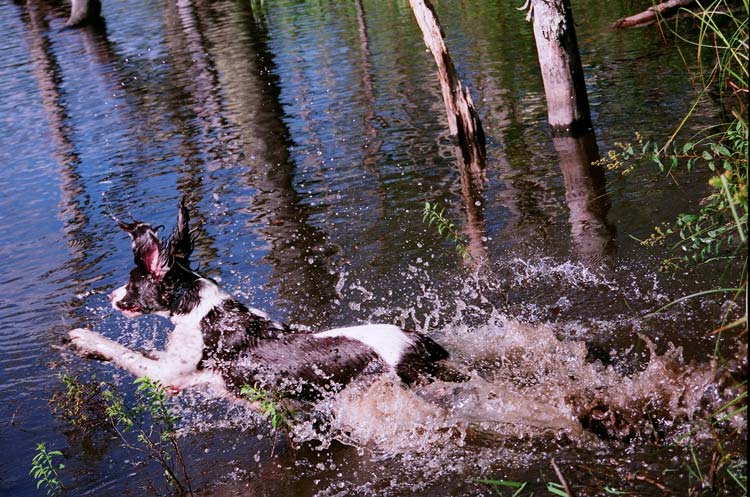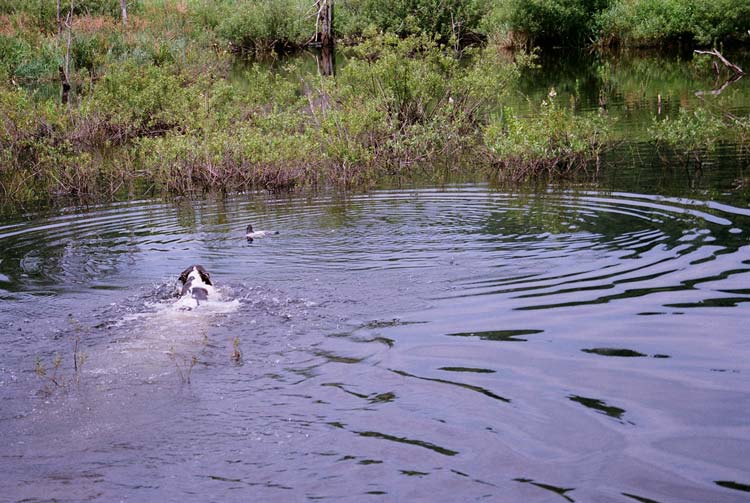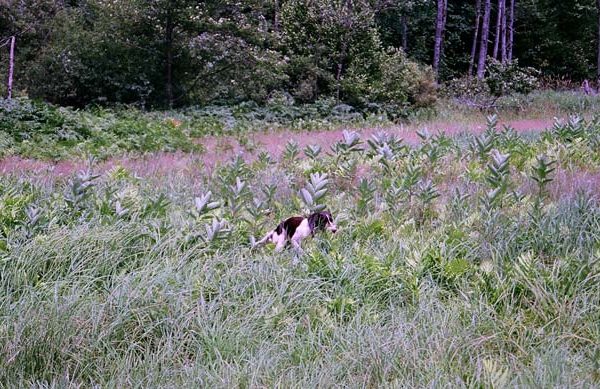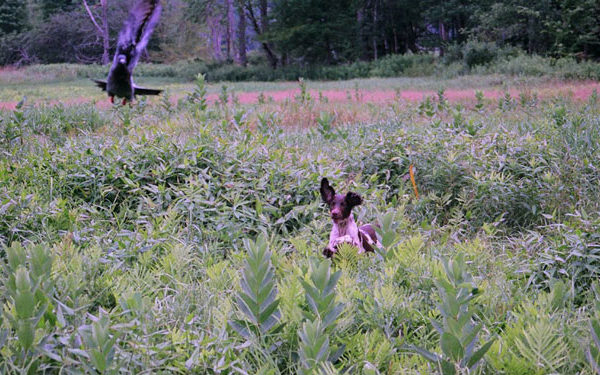
Time has passed and your spaniel has progressed in their training. You now should be well on the way to creating a finely tuned team! Lining and handling on land blinds should be part of your spaniel’s routine during field training. Now the time has come to make the transition from land to water. We are now going to introduce our spaniel to water blinds. There are many cases that will arise when you will need your spaniel to take a line and handle a blind retrieve. Many of these type of cases will involve water. Perhaps you have shot a rooster that has landed in a flowing current, or maybe you have wounded a duck that swims to the reeds on the opposite bank. A crippled duck may dive and resurface fifty yards from where it initially fell. These can common occurrences for the upland and water fowler during their average day a field.
With the gain of popularity of the AKC Spaniel Hunt test. Those of us who enjoy this sporting game, of fine tuning and qualifying our spaniels to meet the AKC standards. Know that the blind retrieve is the most challenging part of the Master Hunter qualifying test. Many of the water blind tests are becoming increasingly difficult. The water blind is getting longer in distance, and there are many more difficult environmental hazards and cover changes that are being introduced. Mastery of the land blind is not, however the only prerequisite for your spaniel. The spaniel should have a very solid water entry before this training can begin. They should go straight into the water. No bank running or hesitation before their water entry. Any and all water entry issues must be fully resolved before you begin the water blind training.
OK that being said, naturally you will need access to a pond more than one will be a great advantage. The banks should have a gradual slopping entry for the spaniel. Complete access around the perimeter of the pond will also be a great advantage as well. The ideal pond will be in a secluded area. Have a cove and peninsula as well as an island. Naturally, the more environmental hazards and cover change that you can expose the spaniel to, the better. You will need white and orange dummies, birds and in the beginning stages a helper and also some sort of a boat. We are going to apply most of the same training techniques that we have learned. While teaching our spaniel the land blinds. Lining and cast drills will be used both in and out of water.
We will start the introduction to water blinds by the used of the floating blind. Find an area in the pond that has no moving current so the dummy will stay in place once it has been put out. Keep your spaniel somewhere that they cannot see you set up this drill. Simply take a large white dummy and toss it out into, a somewhat large area in the pond. Only toss the dummy out about 10 to 15 yards to start! Retrieve your spaniel, hup them on the shore line so the floating blind is in plain sight! Once they are locked onto the white dummy, go through the sequence of commands and send for the retrieve. Your spaniel should leap enthusiastically into the pond and make the retrieve! However if for some bizarre reason the dog refuses to enter the water, simply toss another white dummy into the water next to the other, give a “dead bird” command and send the spaniel. Once the dummy is retrieved, send them back for the other dummy still floating. Continue this form of drills, progressively moving the floating blind out further and further extending the length of their initial line as they gain in confidence. Sixty or so yards for the initial line should be sufficient for now.
Now let’s move to another area of the pond. Preferably a location that will give you access to the opposite shore line. That will give your spaniel at least a 60 + yards to swim before reaching the opposite bank. This location will become a permanent pattern blind area for you. Set your find area so that your spaniel will be able to get out onto the shoreline. Additionally, the area should allow your spaniel the room to take a left or right hand cast, once they are on the shoreline in the find area. You will need to bring along a helper for the introduction to this drill. Set a pile of white dummies, just on the water’s edge of opposite bank. Have assistant hide in the cover on that side of the find area. Retriever your spaniel, line them and send to pile for a retrieve. Should the spaniel start to slow or fade off line, have the assistant throw a dummy to the pile on the bank. This will straighten out the dog’s line and facilitate the retrieve. Additionally, this is a good time to remind you to keep your dog” honest” on its return! Should they pick up a dummy and not come right back into the water, hit the HUP whistle. Once they are HUPPED facing you, recall them back into the water. We want our spaniel to take the straightest route back to you for the delivery. We want them to understand that this is the proper route back to you with the retrieve. Once you have them lining to the pile retrieving several dummies. Returning honestly on all sends to the pile you are ready for the next level of drills.
Now let’s load the pile with one white and several orange dummies. Let’s now send your spaniel, they should retrieve the white dummy first. Should they for some reason choose an orange one instead? Have your assistant remove the white dummy while your spaniel is swimming back to you with the retrieve. Send your dog again for a few more of the orange dummies on the opposite shore line. This will start to develop a mental picture in your spaniels mind. Again if they start to fade off line or begin to slow down. Have your assistant once again throw a white dummy to the pile to identify it for your dog. Eventually they will be retrieving all the colored dummies that you have put out to make a pile.
Next let’s move the pile a few yards further up the land and into cover! Send your dog, once they reach the opposite side, HUP and cast them on a BACK command to the pile. This will teach them to get completely out of the water and travel further back into the cover on land for a retrieve. The next progression is to move the dummy around the area as you continue working this drill. Working on stopping and casting drills, this will instill the seek mode of your spaniel for the scent cone as well. Keep in mind that you are only going to set out one dummy at every blind drill. We are going to do single finds here, this will allow you to work on one specific cast at a time. Also you must remember to run that same drill at least twice before ending the session for the day. Again running the drill twice will add to the mental picture your dog is developing in their mind about water blinds. Your final result is your spaniel will swim confidently and enthusiastically to opposite bank and handle for a blind retrieve. You can return to this drill anytime you need, to smooth out your water blind handling throughout your water blind training.
The next progression addresses the concept of handling on water. Locate a spot on the pond that is thirty yards from the opposite bank and at least 40 yards from side to side on either bank. Let’s set one white dummy out at the BACK pile along with several orange ones. Run your spaniel to make some retrieves at the BACK pile across the pond. Once learned you can add a floating white dummy for a cast, at first or third base which ever you choose. Stop them half way while swimming and cast them over to the white floating dummy. Now some spaniels will naturally tread water, others will slow down but start to swim in your direction. Don’t be too concerned with this issue. They will pick up the art of treading water as they gain in confidence to being handled on water. The goal here is to be able to run this drill with both white then finally orange dummies.
This also is a good time to teach them to enter water on the BACK command from a remote position in front of you. This will help then to understand a re-entry into another body of water. Should you have to send them through water up on land and through or into another body of water? Use all white dummies at the back pile when teaching this remote re-entry. Once again, if refusals to go, crop up throw a dummy over their head to the pile for encouragement on this drill. Next month we will get into advance water blind training. Until then enjoy the water. This is my favorite part of dog training!





